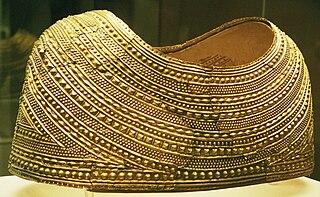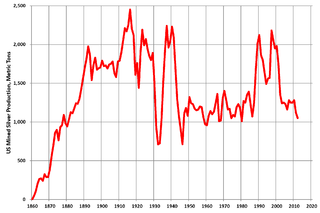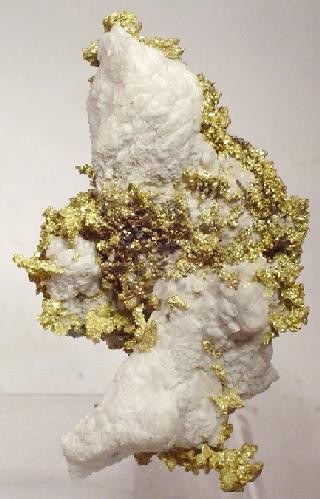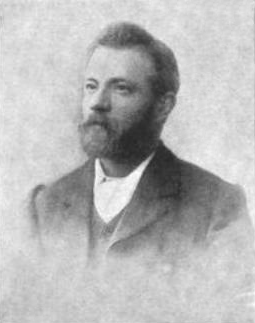| Gibralter Hill | |
|---|---|
| Highest point | |
| Elevation | 522 m (1,713 ft) |
| Prominence | 17 |
| Coordinates | 35°16′34″S148°03′24″E / 35.27611°S 148.05667°E |
Gibralter Hill (also known as Gibraltar Hill) is a hill near Grahamstown, New South Wales, Australia. [1] [2]
| Gibralter Hill | |
|---|---|
| Highest point | |
| Elevation | 522 m (1,713 ft) |
| Prominence | 17 |
| Coordinates | 35°16′34″S148°03′24″E / 35.27611°S 148.05667°E |
Gibralter Hill (also known as Gibraltar Hill) is a hill near Grahamstown, New South Wales, Australia. [1] [2]

In one week in April, 1864, almost 550 ounces of gold were mined from Gibralter Hill, a yield of more than 58 ounces per ton of ore. [4] In 1893 the Gibraltar Gold Mining Company exhibited gold ore from the hill at the World's Columbian Exposition in Chicago yielding a net of 6 ounces of gold per ton. [5]
In 1894 the Gibraltar Hill Company took 656 tons of ore from the hill, which yielded 2090 ounces of gold. [6] In 1895 more than 1500 ounces of gold were mined from the hill by the Gibraltar Gold Mining Company; by this time the yield was still 5 ounces per ton of ore. [7]
The mine was bought by English interests, with capital of £300,000, in 1896, and greatly expanded. £500,000 worth of gold was won before the grades declined and the company ceased mining, [8] in 1901. The mine then continued to be worked, on a small scale, by tribute miners. The company resumed operations in December 1907, [9] but the mine was closed by 1916.

A gold rush or gold fever is a discovery of gold—sometimes accompanied by other precious metals and rare-earth minerals—that brings an onrush of miners seeking their fortune. Major gold rushes took place in the 19th century in Australia, Greece, New Zealand, Brazil, Chile, South Africa, the United States, and Canada while smaller gold rushes took place elsewhere.

Cobar is a town in central western New South Wales, Australia whose economy is based mainly upon base metals and gold mining. The town is 712 km (442 mi) by road northwest of the state capital, Sydney. It is at the crossroads of the Kidman Way and Barrier Highway. The town and the local government area, the Cobar Shire, are on the eastern edge of the outback. At the 2016 census, the town of Cobar had a population of 3,990. The Shire has a population of approximately 4,700 and an area of 44,065 square kilometres (17,014 sq mi).

Welsh gold is gold found in natural geological deposits in two distinct areas of Wales and highly prized because of its origin and scarcity.

Silver mining in the United States began on a major scale with the discovery of the Comstock Lode in Nevada in 1858. The industry suffered greatly from the demonetization of silver in 1873 by the Coinage Act of 1873, known pejoratively as the "Crime of 73", but silver mining continues today.
Gold mining in Colorado, a state of the United States, has been an industry since 1858. It also played a key role in the establishment of the state of Colorado.
Silver mining in Colorado has taken place since the 1860s. In the past, Colorado called itself the Silver State.
Silver mining in Nevada, a state of the United States, began in 1858 with the discovery of the Comstock Lode, the first major silver-mining district in the United States. Nevada calls itself the "Silver State." Nevada is the nation's second-largest producer of silver, after Alaska. In 2014 Nevada produced 10.93 million troy ounces of silver, of which 6.74 million ounces were as a byproduct of the mining of gold. The largest byproducers were the Hycroft Mine, the Phoenix Mine, the Midas Mine and Round Mountain.
Gold mining in Alaska, a state of the United States, has been a major industry and impetus for exploration and settlement since a few years after the United States acquired the territory in 1867 from the Russian Empire. Russian explorers discovered placer gold in the Kenai River in 1848, but no gold was produced. Gold mining started in 1870 from placers southeast of Juneau, Alaska.

The Mining industry of Ghana accounts for 5% of the country's GDP and minerals make up 37% of total exports. Gold contributes over 90% of the total mineral exports. Thus, the main focus of Ghana's mining and minerals development industry remains focused on gold. Ghana is Africa's largest gold producer, producing 80.5 t in 2008. Ghana is also a major producer of bauxite, manganese and diamonds. Ghana has 20 large-scale mining companies producing gold, diamonds, bauxite and manganese; over 300 registered small scale mining groups; and 90 mine support service companies. Other mineral commodities produced in the country are natural gas, petroleum, salt, and silver.

The Fairbanks mining district is a gold-mining area in the U.S. state of Alaska. Placer mining began near Fairbanks in July 1902, after Felix Pedro, an Italian immigrant and Tom Gilmore discovered gold in the hills north of the Tanana and Chena Rivers in 1901. Pedro died exactly eight years after finding the richest gold placer he would ever know. By 1903 a new rush started, and prospectors staked thousands of claims. However, mining results were disappointing during the summer of 1903, with little gold recovered. Then Dennis O'Shea struck it rich on Fairbanks Creek, No. 8 Above. This was one of the richest claims in the Fairbanks Mining District and paid as high as $136 to the pan. Discoveries on Cleary and Ester Creeks followed, and almost two-thirds of the gold mined in the Tanana hills before 1910 came from these three creeks. Total production of gold was more than $30 million. Towns grew on every creek with a combined population of 1,600 residents.
The Telfer Mine is a gold, copper and silver mine located at Telfer on the land of the Martu people, in the Great Sandy Desert of Western Australia. It is owned by Newmont, having acquired the previous owner, Newcrest Mining, formerly the largest gold producer listed on the Australian Securities Exchange, in November 2023.

The Hill 50 Gold Mine, now referred to as the Mount Magnet Gold Mine, is a gold mine located 4 km north-west of Mount Magnet, Western Australia. The mine was, until July 2010, owned by Harmony Gold and had been placed in care and maintenance since 2007. In July 2010, Harmony sold the mine to Ramelius Resources, owner of the Wattle Dam Gold Mine, for A$40 million.

Beria is an abandoned town in the Goldfields-Esperance region of Western Australia, located 8 kilometres (5 mi) north of Laverton on the Laverton-Leonora Road.
Montana silver mining was a major industry in the 1800s following discovery of numerous silver deposits. Between 1883 and 1891 Montana was second every year to Colorado in silver production, except for 1887 when Montana was number one, producing approximately $15.5 million worth of silver. Major mining districts in Montana included Butte, which was home to many important mines such as the Lexington, Alice, and Moulton mines, and Philipsburg, which housed the Granite Mountain and Bimetallic mines. Other influential, but significantly smaller mines, operated at Helena and the Castle Mountains. The rapid raise and fall of these mines were due to largely geological and economic factors that created favorable conditions for a silver mining boom and subsequent bust. Montana continued to produce considerable silver through most of the 1900s, as a byproduct of copper production at Butte.

Gold mining has been a part of Nova Scotia's heritage for 150 plus years and continues to this day. Over a million ounces of gold have been produced in the province since mining began in 1861. Although not as well known as the gold rushes of California, the Klondike, Australia, and South Africa, three distinct rushes resulted in an economic boom in the province and saw the birth and sometimes demise of many new communities.

Content Mine is a heritage-listed former mine at Gulf Developmental Road, Croydon, Shire of Croydon, Queensland, Australia. It was built from 1887 to 1918. It is also known as Content Block Mine. It was added to the Queensland Heritage Register on 4 July 2006.

Homeward Bound Battery and Dam is a heritage-listed stamping mill and reservoir at Croydon, Shire of Croydon, Queensland, Australia. It was built in 1888 by Mr Schumacher. It was added to the Queensland Heritage Register on 21 October 1992.

North Limited was a diversified mining and resources company. Although based in Australia, its operations eventually extended to six continents. By the late 20th century the company had become the fourth largest iron ore exporter in the world with expansion underway which would have made it equal third. Its biggest asset was a majority stake in Robe River, a major miner of the Pilbara iron ore deposits of Western Australia and the world's lowest cost producer of iron ore.

James Hebbard was a miner who became manager of the Great Central Mine, Broken Hill.
Thomas John Greenway FIC was an English metallurgist and mining manager in Australia, closely associated with the development of the Broken Hill mines.